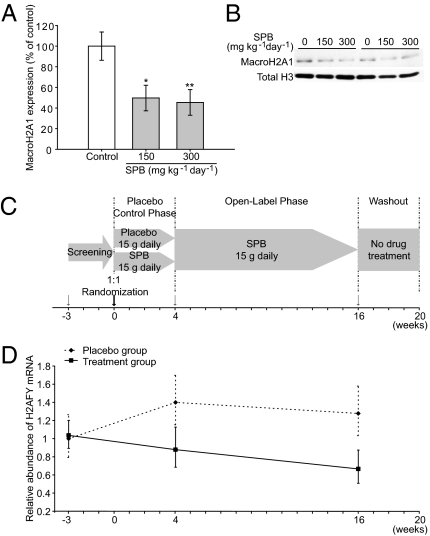Fig. 4.
H2AFY levels mark the pharmacodynamic response to treatment with the HDAC inhibitor SPB, a drug known to suppress huntingtin-induced neurodegeneration in mice. (A and B) R6/2 8-wk-old mice were treated with 150 or 300 mg⋅kg−1⋅d−1 of SPB for 2 wk, and macroH2A1 levels were determined in striatal histone extracts by semiquantitative Western blotting. R6/2 mice treated with 150 or 300 mg⋅kg−1⋅d−1 of SPB show a marked reduction in macroH2A1 levels compared with PBS-treated control mice with P = 0.02 (*) and P = 0.01 (**), respectively. (C and D) H2AFY levels in blood of patients with HD enrolled in a randomized, double-blind, placebo-controlled, phase II clinical trial (Phenylbutyrate Development for Huntington's Disease study). The relative abundance of H2AFY mRNA in SPB-treated and placebo groups was examined at baseline (week −3/visit 1), the end of the placebo-control phase (week 4/visit 4), and the end of the open-label phase (week 16/visit 7) as indicated by arrows. H2AFY expression is significantly down-regulated over time with SPB treatment. Error bars in A and D show SEM. By contrast, time alone (weeks) in the study (adjusting for drug treatment) is associated with a trend toward increasing H2AFY abundance [note subtle increase in H2AFY mRNA abundance in patients with HD (dotted line from week −3 to week 4) treated with placebo only].

